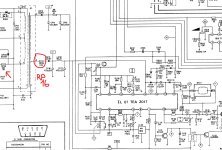Hugo Holden
Veteran Member
One problem with this sort of fault is that whatever change is occurring inside the loop, the loop will move in a direction to compenstate for that change. So lets say there is a problem in the phase detector, either due to a defect in it, or the siganls feeding it (separated sync or the H flyback pulse) the DC Control voltage will skew the H oscillator, then that will case some cancellation of the problem in the phase detector.
Or likewise if the defect is an unstable base frequency in the H oscillator section, the DC output of the phase detector will move to negate some of the change.
In other words a fault anywhere will produce a change everywhere in the H. AFC control system because of the feedback loop.
To get to the bottom of where the fault resides, it is required to break feedback the loop. This is done by disconnecting RL10, where it connects to pin 4, and then feed RL10 with a DC Voltage from a variable power supply so that the H oscillator runs at close to the correct frequency. When that is the case the picture will bee seen to float by horizontally. It is then easy to see if the H oscillator is basically stable, or not and if there are any sudden changes in frequency.
In addition, the voltage output from the phase detector can be monitored with the meter or scope. If the fault is there, there will be a sudden DC shift in its output. This could be due to something happening to the H sync pulses in the composite signal or the separated H sync pulses or the flyback signal. (If the H osc was stable with fixed DC control the flyback frequency would be stable, but its amplitude might not be by the point it gets back to the IC)
Or likewise if the defect is an unstable base frequency in the H oscillator section, the DC output of the phase detector will move to negate some of the change.
In other words a fault anywhere will produce a change everywhere in the H. AFC control system because of the feedback loop.
To get to the bottom of where the fault resides, it is required to break feedback the loop. This is done by disconnecting RL10, where it connects to pin 4, and then feed RL10 with a DC Voltage from a variable power supply so that the H oscillator runs at close to the correct frequency. When that is the case the picture will bee seen to float by horizontally. It is then easy to see if the H oscillator is basically stable, or not and if there are any sudden changes in frequency.
In addition, the voltage output from the phase detector can be monitored with the meter or scope. If the fault is there, there will be a sudden DC shift in its output. This could be due to something happening to the H sync pulses in the composite signal or the separated H sync pulses or the flyback signal. (If the H osc was stable with fixed DC control the flyback frequency would be stable, but its amplitude might not be by the point it gets back to the IC)


